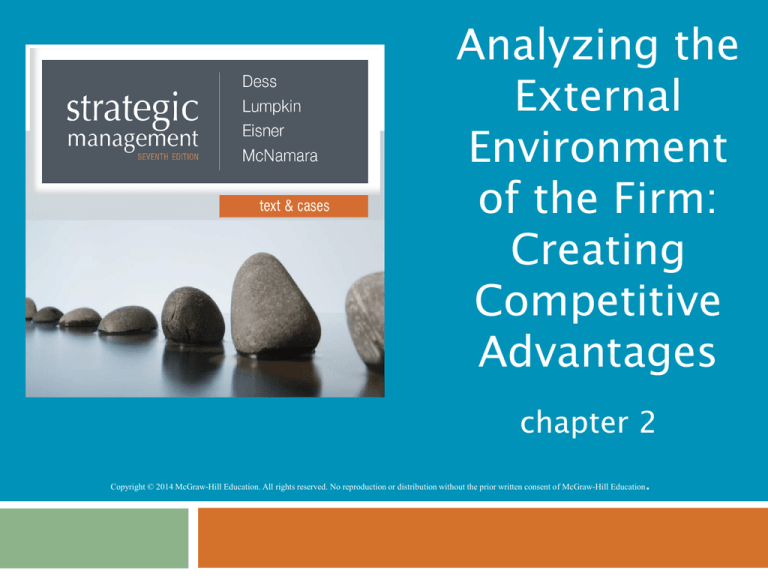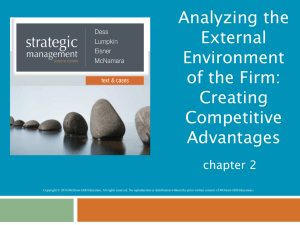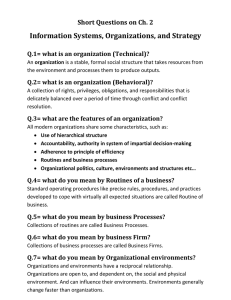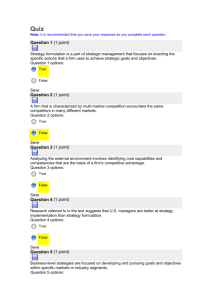
Analyzing the
External
Environment
of the Firm:
Creating
Competitive
Advantages
chapter 2
Copyright © 2014 McGraw-Hill Education. All rights reserved. No reproduction or distribution without the prior written consent of McGraw-Hill Education
.
Learning Objectives
2-2
After reading this chapter, you should have a
good understanding of:
LO1.1 The importance of developing forecasts of
the business environment.
LO1.2 Why environmental scanning, environmental
monitoring, and collecting competitive intelligence
are critical inputs to forecasting.
LO1.3 Why scenario planning is a useful technique
for firms competing in industries characterized by
unpredictability and change.
Learning Objectives
2-3
After reading this chapter, you should have a
good understanding of:
LO1.4 How forces in the competitive environment
can affect profitability, and how a firm can improve
its competitive position by increasing its power visà-vis these forces.
LO1.5 How the Internet and digitally based
capabilities are affecting the five competitive forces
and industry profitability.
LO1.6 The concept of strategic groups and their
strategy and performance implications.
The Importance of External
Environment
2-4
Consider…
If a company does not keep pace
with changes in the external
environment, it becomes difficult to
sustain competitive advantages and
deliver strong financial results.
Creating the Environmentally
Aware Organization
2-5
Exhibit 2.1 Inputs to Forecasting
Environmental Scanning &
Monitoring
2-6
Environmental scanning involves
surveillance of a firm’s external
environment
Predicts
environmental changes to come
Detects changes already under way
Allows firm to be proactive
Environmental monitoring tracks evolution
of environmental trends
Hard
trends – measurable facts/events
Soft trends – estimated, probable events
Competitive Intelligence
2-7
Competitive intelligence
Helps
firms define & understand their industry
Identify rivals’ strengths & weaknesses
Collect
data on competitors
Interpret intelligence data
Helps
firms avoid surprises
Anticipate
competitors’ moves
Decrease response time
Beware
of the potential for unethical behavior
while gathering intelligence
Example: Using Competitive intelligence
2-8
Startups have a disadvantage – it takes a lot of time to be
ready for the market - someone else can get there first.
How to find out if your competitor will beat you to
launch?
Do competitive intelligence:
Monitor the competitor’s blog posts, e-mail blasts, the
CEO's Twitter messages, changes to the LinkedIn profile
Track the dates of each dispatch on a spreadsheet and look
for patterns
When the company’s chatter becomes more frequent,
broadcasting more and more positive messages about its
new product, "It led me to believe they were entering launch
mode” so “we put together a limited version of our software
and released it to get the Qworky name out first.”
Environmental Forecasting
2-9
Environmental forecasting predicts change
Plausible
projections about
Direction
of environmental change?
Scope of environmental change?
Speed of environmental change?
Intensity of environmental change?
Scenario analysis involves detailed
assessments of the ways trends may affect
an issue & development of alternative
futures based on these assessments
Question?
2-10
A danger of forecasting discussed in the
text is that
A.
B.
C.
D.
in most cases, the expense of collecting the
necessary data exceeds the benefit.
forecasting’s retrospective nature provides
little information about the future.
managers may view uncertainty as “black and
white” while ignoring important “gray areas”.
it can create legal problems for the firm if
regulators discover the company is making
forecasts.
SWOT Analysis
2-11
SWOT analysis is a basic technique for
analyzing firm and industry conditions
Firm
or internal conditions = Strengths &
Weaknesses
Where
the firm excels or where it may be lacking
Environmental
or external conditions =
Opportunities & Threats
Developments
that exist in the general
environment
Activities among firms competing for the same
customers
SWOT Analysis
2-12
SWOT analysis
Forces
managers to consider both internal &
external factors simultaneously
Makes firms act proactively
Raises awareness about role of strategy
A
firm’s strategy must build on its strengths,
Remedy the weaknesses or work around them,
Take advantage of the opportunities presented
by the environment, and
Protect the firm from the threats.
Example: SWOT Analysis
2-13
Southwest Airlines SWOT
Strengths
Strong
culture, employee relationships
Weaknesses
Lack
of cultural fit with new AirTran employees
Opportunities
Consolidation
in the airline industry means more
routes or acquisition targets might be available
Threats
Economic
conditions/jet fuel prices might affect
profitability in the future
The General Environment
2-14
The general environment is composed of
factors that are both hard to predict and
difficult to control:
Demographic
Sociocultural
Political/Legal
Technological
Economic
Global
The Demographic Segment
2-15
Demographics are easily understandable &
quantifiable:
Aging
population
Rising affluence
Changes in ethnic composition
Geographic distribution of population
Greater disparities in income levels
The Sociocultural Segment
2-16
Sociocultural forces influence the values,
beliefs, and lifestyles of a society:
More
women in the workforce
Dual-income families
Increase in temporary workers
Greater concern for healthy diets & physical
fitness (increasing levels of obesity)
Greater concern for the environment
Postponement of marriage & family
formation, having children
The Political/Legal Segment
2-17
Political/Legal processes & legislation
influence environmental regulations with
which industries must comply:
Tort
reform
Americans with Disabilities Act (ADA)
Deregulation of utilities & other industries
Increases in minimum wages
Taxation at local, state, federal levels
Legislation on corporate governance reforms
Affordable Health Care Act
The Technological Segment
2-18
Technological developments lead to new
products & services; can create new
industries & alter existing ones:
Genetic
engineering
Computer-aided design/computer-aided
manufacturing systems (CAD/CAM)
Research in synthetic & exotic materials
Pollution/global warming
Wireless communications
Nanotechnology
The Economic Segment
2-19
Economic forces affect all industries:
Interest
rates
Unemployment
Consumer Price Index
Trends in GDP & net disposable income
Changes in stock market valuations
The Global Segment
2-20
Global forces offer both opportunities &
risks:
Increasing
global trade
Currency exchange rates
Emergence of the Indian & Chinese
economies
Trade agreements among regional blocs
(NAFTA, EU, ASEAN)
Creation of WTO (leading to decreasing
tariffs/free trade in services)
Increased risks associated with terrorism
The Competitive Environment
2-21
The competitive environment consists of
factors in the task or industry
environment that are particularly relevant
to a firm’s strategy:
Competitors
(existing or potential)
Including
those considering entry into an entirely
new industry
Customers
(or buyers)
Suppliers
Including
those considering forward integration
Porter’s Five-Forces Model of
Industry Competition
2-22
Exhibit 2.4 Porter’s Five-Forces Model of Industry Competition
Source: Adapted and reprinted with permission of The Free Press, a division of Simon & Schuster Adult Publishing
Group, from Competitive Strategy: Techniques for Analyzing Industries and Competitors by Michael E. Porter.
Copyright © 1980, 1998 by The Free Press. All rights reserved.
The Threat of New Entrants
2-23
The threat of new entrants - possibility that the
profits of established firms in the industry may
be eroded by new competitors.
Depends on existing barriers to entry:
Economies of scale
Product differentiation
Capital requirements
Switching costs
Access to distribution channels
Cost disadvantages independent of scale
Question?
2-24
If you are considering opening a new
pizza restaurant in your community, what
would be the threat of new entrants? How
would you evaluate Porter’s other forces
for this industry? Explain.
The Bargaining Power of Buyers
2-25
Buyers have bargaining power:
Buyers can force down prices, bargain for
higher quality or more services, play
competitors against each other.
Buyer groups are powerful when:
Purchasing
standard products in large volumes
Profits are low & switching costs are few
Backward integration is possible
Quality is not affected by industry product
The Bargaining Power of Suppliers
2-26
Suppliers can exert bargaining power by
threatening to raise prices or reduce the quality
of purchased goods and services.
Supplier groups are powerful when:
Only a few firms dominate the industry
No competition from substitute products
Suppliers sell to several industries
Buyer quality is affected by industry product
Products are differentiated & have switching costs
Forward integration is possible
The Threat of Substitute Products
& Services
2-27
Substitute products & services limit the
potential returns of an industry by placing
a ceiling on the prices that firms can
profitably charge.
Substitutes come from another industry
Can perform the same function as the
industry’s offerings
The more attractive the price/performance
ratio, the more the substitute erodes
industry profits.
The Intensity of Rivalry Among
Competitors in an Industry
2-28
Rivalry tactics include price competition,
advertising battles, new product
introductions, increased customer service or
warranties
Interacting factors lead to intense rivalry:
Numerous or equally balanced competitors
Slow industry growth
High fixed or shortage costs
Lack of differentiation or switching costs
Capacity augmented in large increments
High exit barriers
How the Internet and Digital
Technologies Affect Competitive Forces
2-29
Using Industry Analysis: A Few
Caveats
2-30
Managers must not always avoid low profit
industries – these can still yield high returns for
players who pursue sound strategies
Five forces analysis implicitly assumes a zerosum game – yet mutually beneficial relationships
can still be established with buyers & suppliers
Five forces analysis is essentially a static analysis
– yet external forces can still change the
structure of all industries
See the value net
Vertical dimension = suppliers & customers
Horizontal dimension = substitutes & complements
The Value Net
2-31
Exhibit 2.6 The Value Net
Source: reprinted by permission of Harvard Business Review. Exhibit from “The Right Game: Use Game Theory to
Shape Strategy,” by A. Brandenburger and B.J. Nalebuff, July-August 1995. Copyright © 1995 by the Harvard
Business School Publishing Corporation. All rights reserved.
Doing a Good Industry Analysis
2-32
Good industry analysis looks rigorously at
the structural underpinnings & root
causes of profitability
Must
choose the appropriate time frame
Consider
the industry business life cycle
Average profitability over 3-5 years or longer
Must
consider quantitative factors as well as
qualitative
Get
numbers to quantify five forces factors
Percentages of cost or sales, actual switching costs
Strategic Groups Within Industries
2-33
Two unassailable assumptions in industry
analysis:
No
two firms are totally different
No two firms are exactly the same
Strategic groups – clusters of firms that
share similar strategies:
Breadth
of product & geographic scope
Price/quality
Degree of vertical integration
Type of distribution
Strategic Groups Within Industries
2-34
Exhibit 2.7 The World Automobile Industry: Strategic Groups
Note: Members of each strategic group are not exhaustive, only illustrative.
Strategic Groups Within Industries
2-35
Strategic groups as an analytical tool
Helps
identify barriers to mobility that
protect a group from attacks by other groups
Helps identify groups whose competitive
position may be marginal or tenuous
Helps chart the future direction of firms’
strategies
Helps to think through the implications of
each industry trend for the strategic group as
a whole




